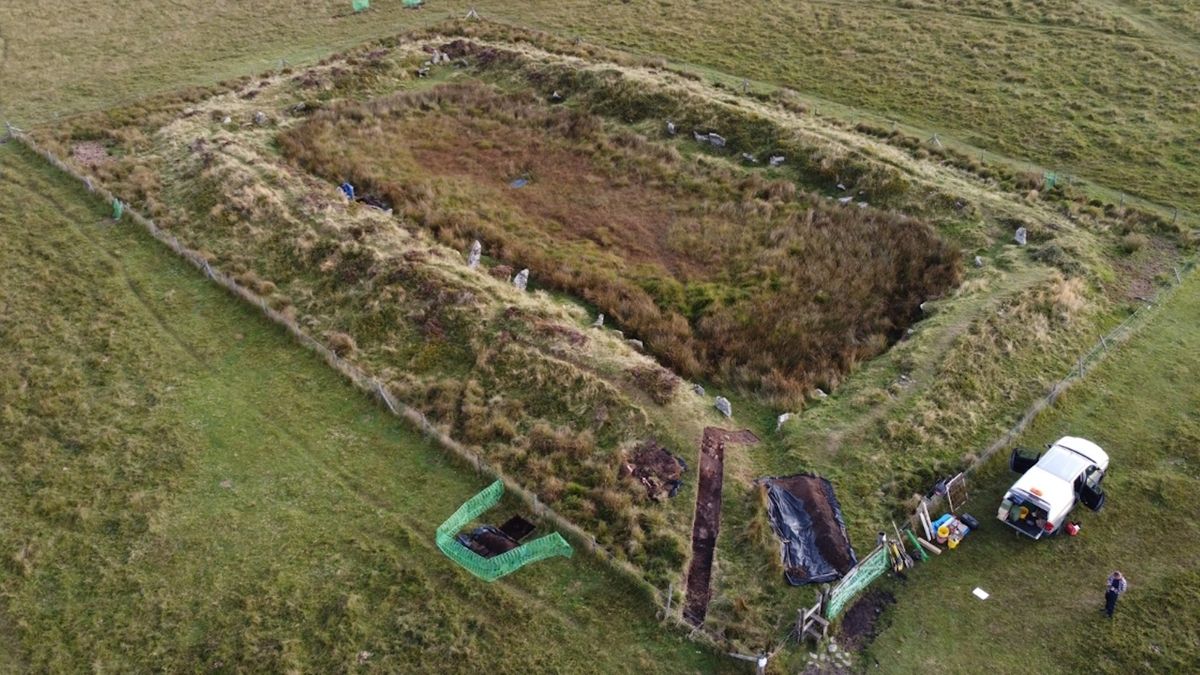A structure in southwest England that’s associated with King Arthur isn’t medieval as scientists had long thought. Instead, it dates back more than 5,000 years, to the Neolithic, or New Stone Age, archaeologists say — thousands of years before the mythical king and his knights are said to have lived.
The scientists who were involved in recent excavations at “King Arthur’s Hall,” an unusual rectangular structure on the Bodmin Moor in Cornwall, used several dating techniques to establish that the hall was built between 5,000 and 5,500 years ago.
The results challenge the idea that the structure had anything to do with the mythical Arthur, who would have lived in the fifth or sixth centuries A.D. — although most historians think he didn’t exist at all and, in reality, was a medieval fiction based on traditional tales.
“Given that the monument is now 4,000 years older than most people thought, we now need to consider the monument within the context of Bodmin Moor’s prehistoric landscape,” Tim Kinnaird, a geochronologist at the University of St Andrews in Scotland, told Live Science.
Related: Graves of dozens of kings from the time of King Arthur uncovered in Britain
Kinnaird is an expert in optically stimulated luminescence (OSL), which can estimate when certain minerals were last exposed to the sun. The OSL results were combined with other dating techniques, such as the radiocarbon dating of buried pollen and insect eggs, to determine the age of the mysterious structure.
King Arthur’s Hall isn’t the only Neolithic structure associated with Arthur. Arthur’s Stone, a 5,700-year-old chambered tomb in Herefordshire, is also linked through legend to the medieval king, with one story claiming that a giant battling Arthur at the site fell and left an imprint of its elbow on the tomb.
King Arthur’s Hall
King Arthur’s Hall is an unusual solitary structure on a remote part of Bodmin Moor; the name “moor” here means “open uplands,” possibly from an Old English word meaning “swamp.” It is rectangular, consists of a bank of earth and stone measuring about 69 by 160 feet (21 by 49 meters), and is studded with 56 standing stones on the inner face of the embankment.
Historic England, a government agency, had listed the structure as a medieval animal pound, although its standing stones and north-south alignment suggested it might be prehistoric. Now, the new dating has established that the structure was built in the late fourth millennium B.C., during the Neolithic — a discovery that indicates it is older than the oldest parts of Stonehenge.
Kinnaird said in an email that King Arthur’s Hall had now been revealed as one of several prehistoric monuments on Bodmin Moor, which indicates an active Neolithic community had built a rich landscape of monuments there. Other nearby Neolithic structures include “tor enclosures,” such as Rough Tor; standing stones; and “long barrows” (burial mounds).
Death of Arthur
Cornwall’s Bodmin Moor has long been regarded in legends as the site of Arthur’s final Battle of Camlann. According to medieval Welsh texts, Arthur and his knights fought in the sixth century against the rebel forces of Mordred at Camlann — a location identified by some as the Cornish town of Camelford on the edge of Bodmin Moor, although there are rivals for the claim.
Legends say Mordred — either Arthur’s nephew or illegitimate son, according to various authors — was killed in the battle, while Arthur was fatally wounded and taken by a magical boat to the mystical island of Avalon.
Several ancient sites around Bodmin Moor are linked with Arthurian legends, and in the 16th century it was said Arthur himself had frequented King Arthur’s Hall. But the new results show the structure must have already been thousands of years old if Arthur ever went there.
A spokesperson for the Cornwall Archaeology Society, which was also involved in the excavations, said the association with Arthur reflected the structure’s unknown origins.
“The romantic sounding 16th century name ‘King Arthur’s Hall’ tells us that here is a place regarded by the moorland community as something ancient and unfathomable, like other sites attributed to Arthur,” Pete Herring, president of the Cornwall Archaeology Society, said in a statement.


